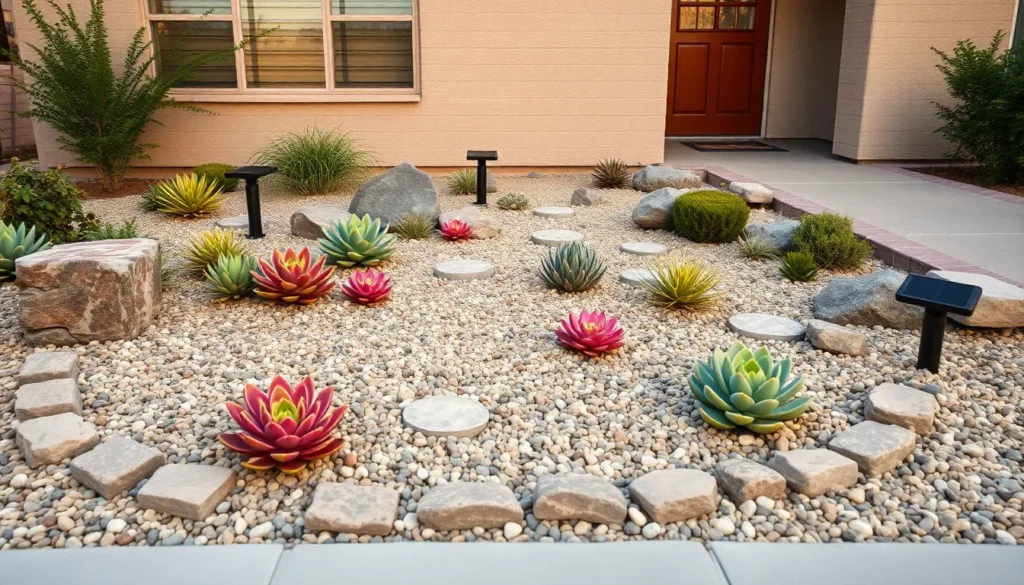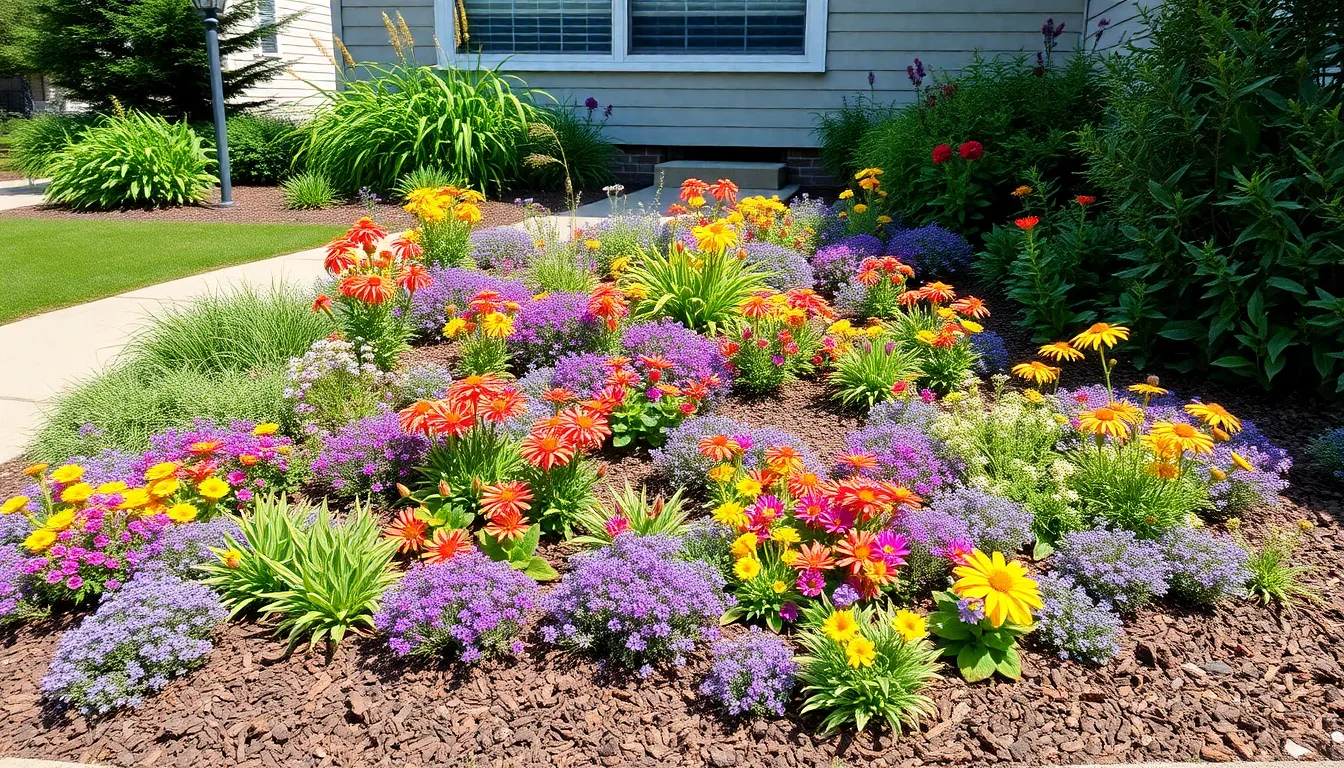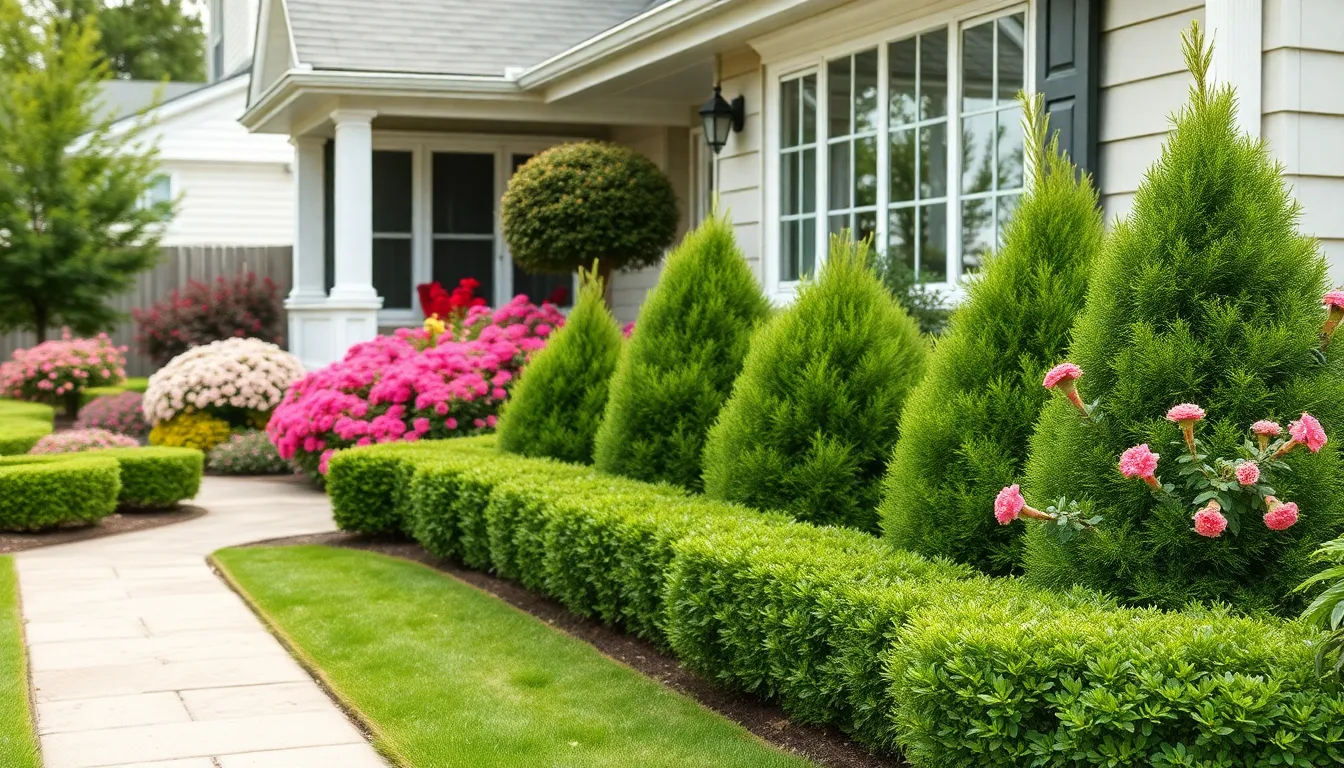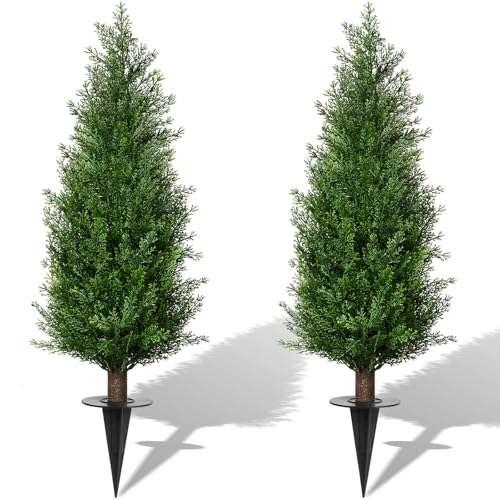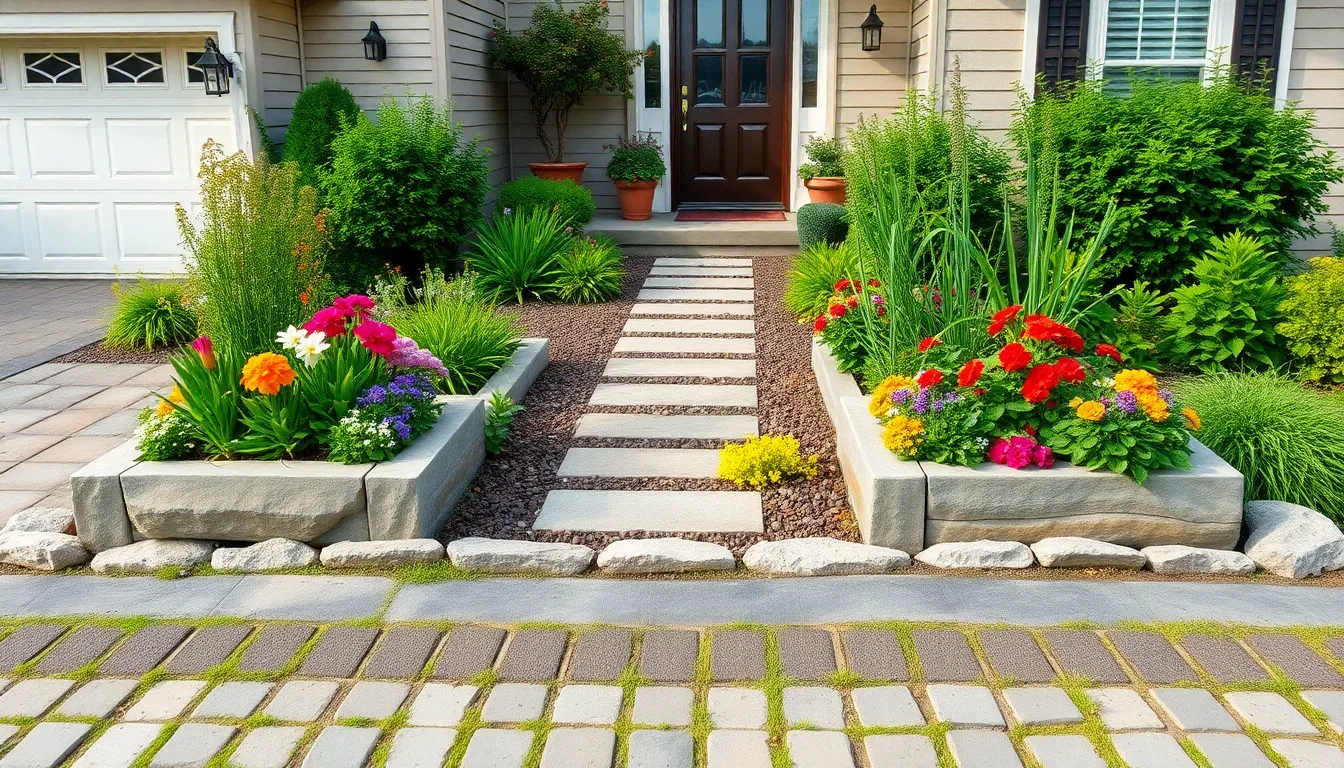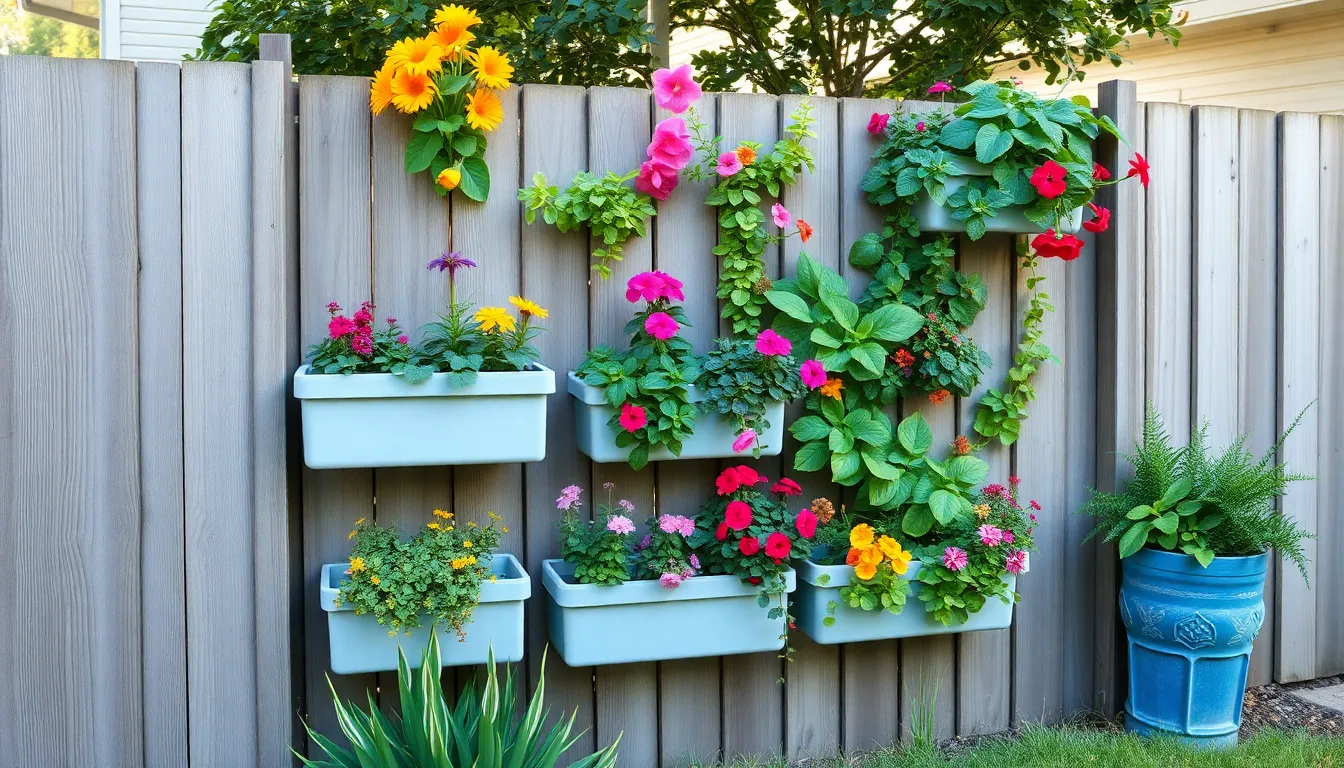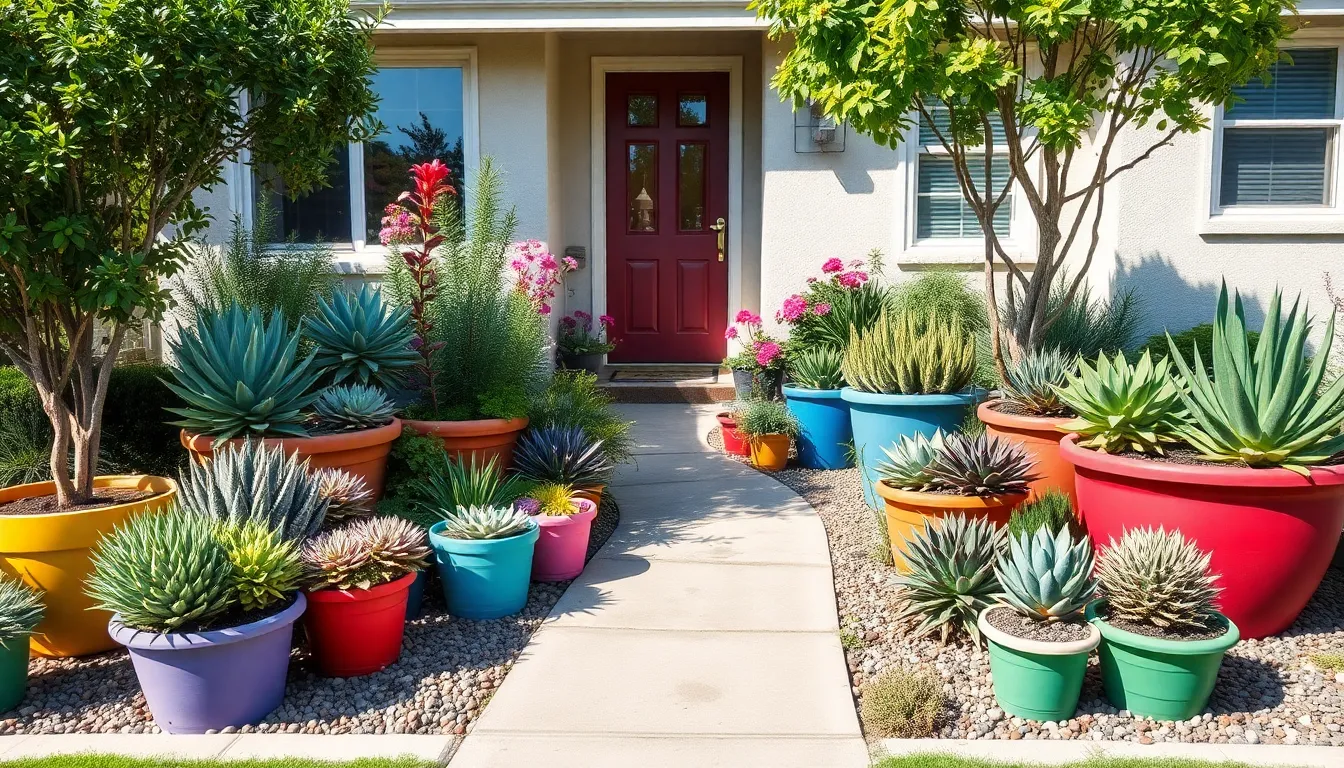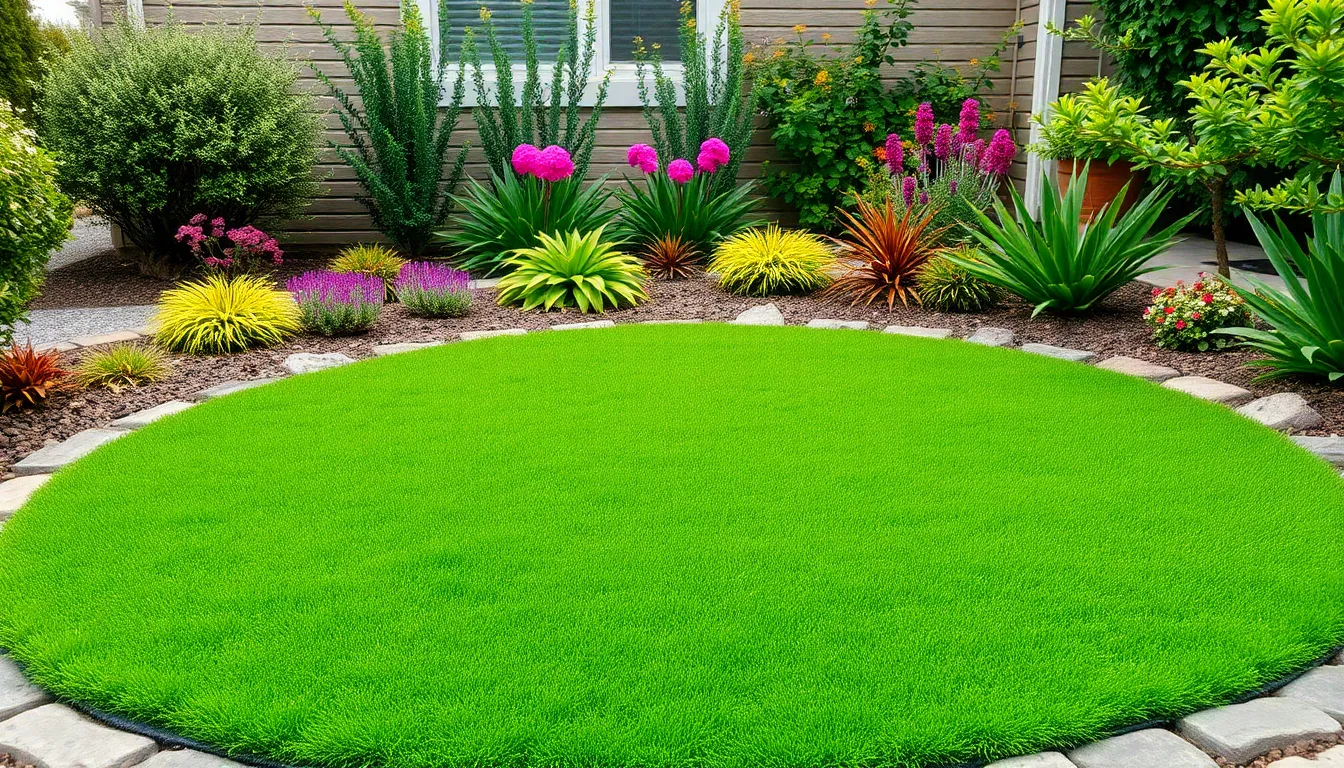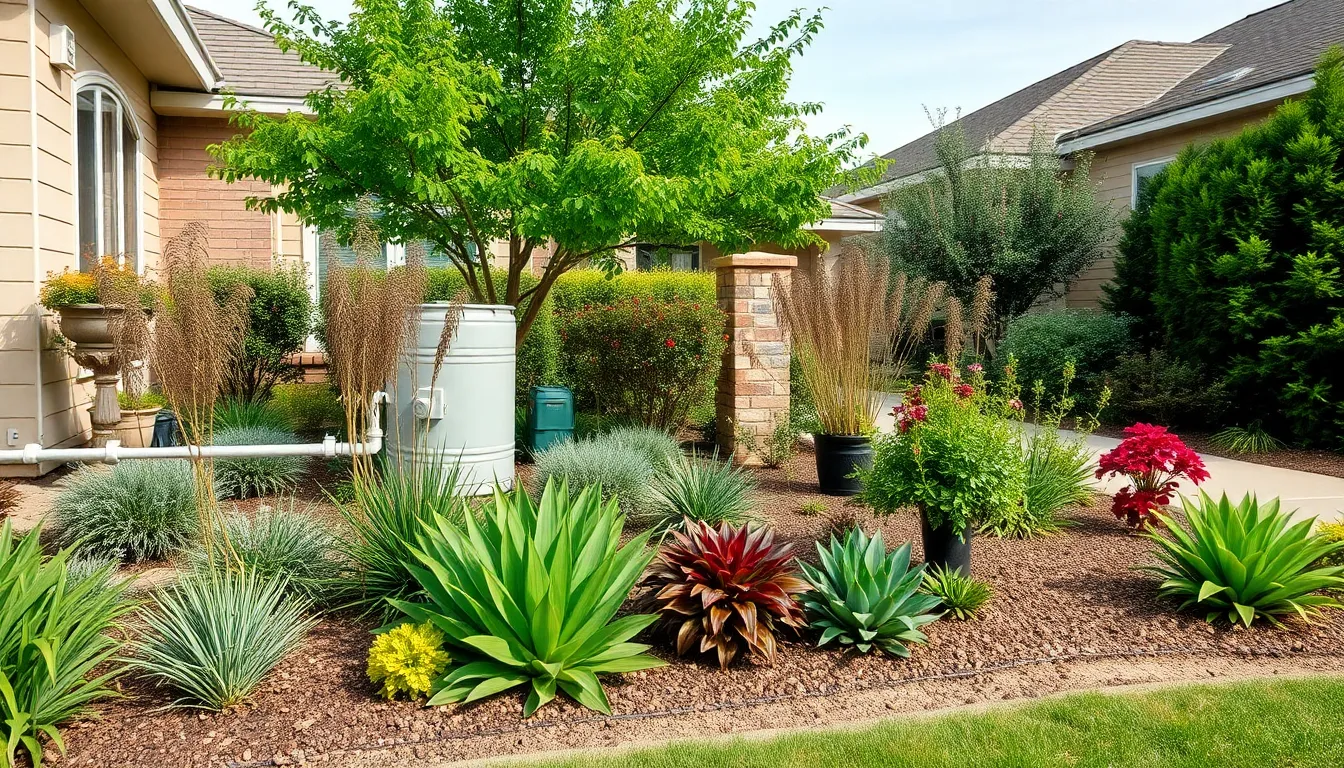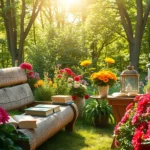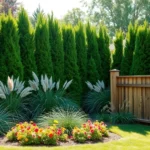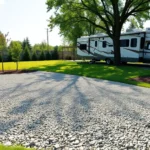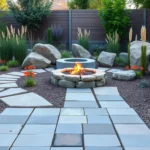We all dream of a stunning front yard that boosts our home’s curb appeal without demanding every weekend of our lives. The reality? Most of us don’t have sprawling lawns or unlimited time to maintain elaborate gardens. That’s where smart low-maintenance landscaping comes to the rescue.
Small front yards present unique opportunities to create maximum impact with minimal effort. We’ve discovered that the secret lies in choosing the right plants, materials, and design elements that practically take care of themselves. From drought-resistant succulents to decorative gravel paths, these answers work harder so you don’t have to.
Whether you’re dealing with challenging soil conditions, limited space, or simply want more time to enjoy your outdoor space rather than maintaining it, we’ll show you how to transform your front yard into a beautiful, welcoming entrance that thrives with minimal intervention.
Create a Minimalist Rock Garden Design
Rock gardens offer the perfect solution for small front yard spaces that demand style without constant maintenance. We can transform even the most challenging front yard areas into stunning focal points using carefully selected materials and plants.
Choose Drought-Resistant Succulents
Succulents form the backbone of any successful minimalist rock garden because they thrive in harsh conditions while providing year-round visual interest. We recommend selecting varieties like hens and chicks (Sempervivum), jade plants, and echeveria that naturally complement rocky environments. These plants store water in their thick leaves and require watering only once every 7-10 days during growing season.
Grouping succulents in odd numbers creates more natural arrangements that catch the eye without overwhelming small spaces. We suggest planting three or five specimens of the same variety together for maximum impact. Sedum varieties like stonecrop and autumn joy spread naturally to fill gaps between rocks while requiring virtually no care once established.
Color combinations work best when we stick to 2-3 complementary hues throughout the garden design. Blue-green agave pairs beautifully with burgundy hens and chicks while silver-toned ghost plants provide neutral contrast against darker stone materials.
Incorporate Decorative Gravel and Stone Pathways
Gravel pathways eliminate the need for regular lawn maintenance while directing foot traffic through our front yard design. We can choose from decomposed granite, pea gravel, or crushed stone depending on the overall aesthetic we want to achieve. Decomposed granite compacts well and costs approximately $3-5 per cubic yard while providing a clean contemporary look.
Stone placement requires strategic planning to create visual flow without appearing cluttered or chaotic. We place larger boulders first as anchor points then fill surrounding areas with medium-sized rocks and smaller decorative stones. River rocks work particularly well around succulent plantings because they retain heat during the day and slowly release it at night.
Edging materials keep gravel contained and prevent it from spreading into surrounding industry areas. Steel edging strips cost around $2-4 per linear foot and create crisp clean lines that enhance the minimalist aesthetic we’re trying to achieve.
Add Strategic Lighting for Evening Appeal
Low-voltage LED lights transform rock gardens into dramatic nighttime focal points while consuming minimal electricity throughout the year. We recommend installing 2-3 watt LED spotlights positioned to highlight our most interesting rock formations or succulent groupings. These fixtures typically consume less than $20 annually in electricity costs.
Solar-powered pathway lights eliminate the need for electrical wiring while providing subtle illumination along gravel walkways. We space these lights 6-8 feet apart to create even coverage without creating harsh shadows or overly bright spots. Modern solar fixtures charge during daylight hours and automatically illuminate for 6-8 hours after sunset.
Uplighting techniques work particularly well with larger boulder arrangements because they create interesting shadow patterns against nearby walls or fencing. We position fixtures at the base of rocks and angle them upward at 30-45 degree angles for optimal visual impact.
Install Native Ground Cover Plants
Native ground covers transform small front yards by replacing traditional lawns with plants that naturally thrive in your local climate. We recommend these hardy alternatives because they reduce water consumption by up to 50% compared to conventional grass while preventing weed growth through effective soil coverage.
Select Regional Perennials for Year-Round Interest
Perennial plants provide the foundation for sustainable front yard landscaping since they return annually without replanting. Catmint excels in sunny locations, producing fragrant foliage and purple-blue flowers from spring through fall. Coreopsis delivers bright yellow blooms that attract beneficial pollinators while tolerating drought conditions exceptionally well.
Partial shade areas benefit from heuchera, which offers colorful foliage in burgundy, lime green, or coral tones throughout the growing season. Dicentra complements shade gardens with delicate heart-shaped flowers and feathery leaves that create textural interest. These regional perennials establish deep root systems that improve soil structure while requiring minimal intervention once established.
Use Mulch to Suppress Weeds and Retain Moisture
Mulching creates a protective barrier that prevents weed seeds from germinating while keeping soil moisture levels consistent. Organic mulch options like shredded bark or wood chips decompose gradually, enriching the soil with essential nutrients over time. We apply 2-3 inches of mulch around plants, maintaining a gap near plant stems to prevent moisture-related diseases.
Stone mulch provides permanent weed suppression in areas where water conservation is the primary goal. River rock and decorative gravel reflect heat away from plant roots during summer months while creating visual contrast against green foliage. This approach eliminates the need for annual mulch replacement while maintaining professional industry appearance.
Group Plants by Water Requirements
Zoned watering systems maximize efficiency by clustering plants with similar moisture needs in designated areas. Drought-tolerant succulents and Mediterranean herbs occupy sunny, well-draining sections that receive minimal supplemental irrigation. Native wildflowers and ornamental grasses thrive in these low-water zones while providing seasonal color changes.
Moderate-water plants including hostas and ferns perform best in shadier locations where natural moisture retention occurs. We separate high-water plants like astilbe into dedicated beds with amended soil that holds moisture longer. This strategic grouping prevents overwatering drought-adapted species while ensuring moisture-loving plants receive adequate hydration without waste.
Design with Evergreen Shrubs and Trees
Evergreen plants form the backbone of any successful low maintenance front yard design. These hardy selections provide year-round structure and color without the seasonal cleanup that deciduous plants demand.
Position Dwarf Conifers as Focal Points
Dwarf conifers serve as natural anchors in small front yard designs, creating visual weight without overwhelming limited space. Their compact growth habit means we can enjoy striking architectural forms that develop slowly over years, requiring minimal pruning or intervention. Strategic placement near entryways or corners helps establish clear sight lines while maintaining the intimate scale that small yards require.
Blue spruce, dwarf Alberta spruce, and compact juniper varieties offer diverse textures and colors that complement any home’s exterior. These selections typically reach mature heights between 3-6 feet, making them perfect for foundation plantings that won’t block windows or create maintenance headaches. We can group three different varieties together to create ever-changing compositions that remain interesting throughout all seasons.
Create Structure with Boxwood Hedging
Boxwood hedging delivers crisp, formal lines that define pathways and borders with minimal upkeep requirements. These versatile shrubs tolerate light pruning once or twice yearly, maintaining their neat appearance without constant attention. Their dense growth habit naturally suppresses weeds while creating clear boundaries between different industry zones.
Common boxwood and winter gem varieties thrive in various light conditions, adapting well to both sunny and partially shaded locations. We can use them to frame flower beds, line walkways, or create low privacy screens that enhance curb appeal. Their evergreen nature ensures our front yard maintains structure even during winter months when other plants go dormant.
Add Seasonal Color with Flowering Bushes
Flowering bushes complement evergreen foundations by introducing seasonal bursts of color without demanding extensive care routines. Selecting varieties suited to our local climate zone minimizes watering needs and reduces the likelihood of pest or disease issues. These plants bridge the gap between permanent structure and ever-changing seasonal interest.
Spirea, weigela, and potentilla offer extended bloom periods with minimal fertilizing requirements, thriving in average soil conditions. Native flowering shrubs like ninebark or serviceberry provide additional benefits by supporting local wildlife while requiring even less intervention. We recommend choosing 2-3 varieties with staggered bloom times to ensure continuous color from spring through fall, creating a industry that evolves naturally throughout the growing season.
Incorporate Hardscaping Elements
Hardscaping elements form the backbone of low maintenance front yard designs. These permanent features reduce ongoing care while adding structure and visual appeal to your outdoor space.
Build Raised Planter Boxes for Easy Maintenance
Raised planter boxes concentrate your planting areas and make maintenance tasks significantly easier by eliminating the need for bending or kneeling. These elevated structures improve soil quality and drainage while providing better control over weed growth and pest management.
We recommend building boxes 18-24 inches high for comfortable access and filling them with quality soil mix. This approach reduces the spread of weeds and pests compared to ground level planting. Adding mulch inside the planter boxes further decreases watering frequency and suppresses unwanted growth.
Constructing raised beds also allows us to customize soil conditions for exact plants. We can create the perfect growing environment without amending entire yard sections. The defined boundaries make it easier to apply fertilizers and maintain consistent watering schedules.
Install Permeable Paving for Reduced Upkeep
Permeable paving materials like porous concrete, gravel, or pavers with gaps allow water to seep through naturally. This installation method reduces runoff and prevents soil erosion while eliminating muddy patches that require constant cleaning.
These surfaces require no watering, fertilizing, or mowing unlike traditional lawn areas. We find that permeable paving cuts down labor significantly compared to maintaining grass or planted beds. Occasional debris removal represents the only regular maintenance needed.
Installing permeable pavers works especially well for driveways, walkways, and functional areas. The materials handle foot traffic and vehicle weight while managing water drainage effectively. This solution addresses both practical needs and aesthetic goals in one hardscaping element.
Create Defined Borders with Natural Stone
Natural stone borders add structure to planting beds and pathways while requiring no upkeep beyond occasional cleaning. Stone borders prevent plant overgrowth and keep mulch or gravel contained within designated areas.
We use natural stone to create clean lines that separate different industry zones. These permanent borders eliminate the need for constant edge trimming and redefining bed boundaries. The stone naturally complements both plants and hardscape elements.
Selecting local stone varieties ensures the borders blend with your regional industry character. Large flat stones work well for substantial borders while smaller river rocks create gentler transitions. The installation requires minimal tools and provides immediate visual impact that lasts for decades.
Maximize Space with Vertical Gardening
When we’re working with limited square footage, vertical gardening transforms walls and fences into productive growing spaces. This approach allows us to create lush landscapes without sacrificing precious ground area.
Install Wall-Mounted Planters
Wall-mounted planters attach directly to walls or fences, making excellent use of vertical space in our compact front yards. These planters work perfectly for small plants, herbs, succulents, or flowers while reducing the need for ground cultivation and frequent maintenance. Installing them at varying heights creates visual interest and allows us to accommodate different plant sizes. We can choose from materials like cedar, metal, or recycled plastic that complement our home’s exterior design. The elevated positioning also improves drainage and makes plant care more accessible.
Use Trellises for Climbing Plants
Trellises support vines and climbing plants that grow upward rather than outward, saving valuable yard space for other design elements. Plants like clematis, jasmine, or ivy provide lush greenery with minimal care once they’re established in our industry. Installing trellises against walls or as freestanding structures creates natural privacy screens while adding vertical dimension. We can select from wooden, metal, or vinyl options that match our aesthetic preferences. The key is positioning them where climbing plants receive adequate sunlight for healthy growth.
Create Living Walls with Modular Systems
Living walls made from modular planter panels allow an array of plants to grow vertically across larger surface areas. These systems can be customized to fit the exact size of our yard and often include drought-tolerant plants that require less watering than traditional gardens. Modular panels connect easily and provide built-in irrigation options for efficient water distribution. We can mix different plant types to create textural variety and seasonal color changes. The self-contained nature of these systems makes plant replacement simple when needed.
Choose Low-Water Container Gardens
Container gardens offer the perfect solution for small front yards when we want stunning visuals without the constant watering demands. We can create beautiful displays using drought-tolerant plants, succulents, and native species that thrive with minimal moisture while maximizing our limited space.
Select Self-Watering Planters
Self-watering planters revolutionize container gardening by maintaining consistent moisture through built-in reservoirs at the base. These innovative containers reduce our watering frequency significantly while preventing the overwatering issues that often damage drought-tolerant plants. We’ll find these planters especially valuable during hot summer months when traditional containers dry out quickly. The reservoir system delivers water directly to plant roots as needed, creating optimal growing conditions with minimal effort from us.
Group Containers for Visual Impact
Arranging containers in clusters creates dramatic visual appeal that makes our small front yard appear larger and more intentional. We should vary the heights and sizes within each grouping to establish natural layers that draw the eye upward and outward. Odd-numbered groups of three or five containers work best for creating balanced, professional-looking displays. This clustering approach also makes maintenance easier since we can care for multiple plants in one location and move entire arrangements when needed.
Rotate Seasonal Displays Easily
Container gardens give us the flexibility to refresh our front yard’s appearance throughout the year without major replanting projects. We can swap out summer annuals for fall mums, then transition to winter evergreens or spring bulbs as seasons change. This adaptability means we’re never stuck with the same look year-round, unlike traditional industry beds that require extensive renovation for seasonal updates. Moving containers to storage during harsh weather protects our investment and extends the life of both plants and planters.
Establish Simple Lawn Alternatives
Traditional grass lawns demand frequent watering, mowing, and fertilizing that can consume our weekends and budget. We can transform our small front yards with smarter alternatives that maintain curb appeal while dramatically reducing maintenance requirements.
Plant Clover or Moss for Green Coverage
Clover provides dense ground coverage that naturally suppresses weeds and requires minimal mowing throughout the growing season. This nitrogen-fixing plant actually improves our soil health while staying green with significantly less water than traditional grass. We’ll find that clover thrives in both sunny and partially shaded areas, making it versatile for various front yard conditions.
Moss thrives exceptionally well in shaded, moist areas where grass typically struggles to establish. Unlike grass, moss eliminates mowing needs entirely while creating a soft, natural carpet that feels comfortable underfoot. We can encourage moss growth by maintaining consistent moisture levels and ensuring our soil remains slightly acidic.
Both alternatives offer year-round green coverage that stays attractive with minimal intervention from us. Establishment requires initial preparation, but once these plants take hold, they’ll provide reliable coverage for years with basic care.
Install Artificial Turf in High-Traffic Areas
Modern artificial turf looks remarkably realistic and performs excellently in areas with heavy foot traffic where natural grass fails. We can eliminate watering, mowing, and fertilizing requirements entirely while maintaining a lush green appearance throughout all seasons. High-quality synthetic grass withstands weather extremes and maintains its color without fading or brown patches.
Installation works best in small, defined areas where we want guaranteed green coverage without ongoing maintenance. Front walkways, entryways, and children’s play areas benefit most from artificial turf’s durability and consistent appearance. We’ll appreciate how artificial turf stays neat and tidy regardless of weather conditions or usage patterns.
Quality synthetic grass products now include realistic texture variations and natural-looking color blends that fool most observers. Professional installation ensures proper drainage and longevity that makes this investment worthwhile for busy homeowners.
Create Gravel Gardens with Accent Plants
Gravel gardens eliminate watering, fertilizing, and mowing needs while providing year-round structure and visual interest. We can choose from river rock, crushed stone, or decorative gravel in colors that complement our home’s exterior and existing industry elements. These hardscaped areas work particularly well in dry climates where water conservation is important.
Drought-tolerant accent plants like succulents, ornamental grasses, and native shrubs thrive when strategically placed throughout gravel gardens. Grouping plants in odd numbers creates natural-looking arrangements that draw the eye without appearing too structured. We should add mulch around planted areas to retain soil moisture and further reduce weed growth.
Pathways and parking strips benefit tremendously from gravel treatment since these areas receive heavy use and look tidy with minimal effort. Stone edging helps contain gravel and creates clean borders that prevent spreading into other industry areas. Proper industry fabric underneath the gravel layer provides long-term weed suppression that keeps maintenance to an absolute minimum.
Design Efficient Irrigation Systems
Smart water management transforms front yard maintenance while keeping plants healthy year-round. These targeted approaches deliver precise watering without the guesswork of traditional sprinkler systems.
Install Drip Irrigation for Targeted Watering
Drip irrigation delivers water directly to plant roots, minimizing waste while ensuring adequate moisture reaches every plant. Installing this system reduces water consumption by up to 30% compared to overhead sprinklers since water goes exactly where it’s needed most.
Position drip emitters 12-18 inches from plant bases to encourage root development without oversaturating surrounding soil. Multiple emitter types accommodate different plant needs, from low-flow options for succulents to higher-output emitters for established shrubs and perennials.
Pressure-compensating emitters maintain consistent water flow regardless of elevation changes across your front yard. Installing inline filters prevents clogging from sediment and debris, ensuring reliable operation throughout the growing season.
Set Up Rain Collection Systems
Rain barrels capture natural precipitation to supplement your irrigation needs while reducing monthly water bills. Position collection systems beneath downspouts to maximize water capture during storm events, with overflow valves directing excess water away from your home’s foundation.
Installing first-flush diverters improves water quality by redirecting initial rainfall that washes debris from roof surfaces. Connecting multiple barrels with linking kits increases storage capacity for extended dry periods when your low-maintenance plants still need occasional watering.
Elevating rain barrels on stable platforms creates natural water pressure for gravity-fed irrigation systems. Adding spigots at different heights allows you to drain collected water completely while maintaining easy access for watering containers and garden beds.
Use Smart Timers for Automated Care
Smart irrigation timers adjust watering schedules based on weather conditions and soil moisture levels, preventing overwatering that can damage drought-tolerant plants. These devices connect to local weather stations to skip scheduled watering when recent rainfall provides adequate moisture.
Programming multiple zones accommodates different plant water requirements throughout your front yard design. Grouping plants with similar needs allows you to customize watering duration and frequency for each area, from water-wise succulents to established native perennials.
Smartphone apps provide remote control over your irrigation system, letting you adjust schedules while traveling or during unexpected weather changes. Installing soil moisture sensors triggers watering only when ground conditions require it, eliminating guesswork and reducing water waste by up to 20%.
Conclusion
Creating a beautiful low-maintenance front yard doesn’t have to be overwhelming or expensive. We’ve shown you that with the right combination of drought-resistant plants native ground covers and smart hardscaping elements you can achieve stunning curb appeal while drastically reducing your weekend chores.
The key lies in working with your industry rather than against it. By choosing materials and plants that thrive in your exact conditions you’ll spend less time maintaining and more time enjoying your outdoor space.
Remember that small changes can make a big impact. Whether you start with a simple container garden or invest in a complete drip irrigation system every step toward low-maintenance landscaping brings you closer to the effortless front yard of your dreams.
Frequently Asked Questions
What are the best plants for a low-maintenance front yard?
Drought-resistant succulents like hens and chicks, jade plants, and echeveria are ideal choices. Native ground cover plants and regional perennials such as catmint and coreopsis also work well. These plants thrive in local climates, require minimal watering, and need little intervention once established, making them perfect for busy homeowners.
How can I reduce water consumption in my front yard landscaping?
Install drip irrigation systems to reduce water usage by up to 30%. Choose native plants and drought-tolerant species that naturally require less water. Group plants by their water requirements and use mulching to retain moisture. Rain collection systems can also capture natural precipitation for watering needs.
What are good alternatives to traditional grass lawns?
Clover provides dense ground coverage and improves soil health while requiring less maintenance. Moss works well in shaded areas and eliminates mowing needs. Artificial turf offers a realistic appearance without upkeep, and gravel gardens with drought-tolerant accent plants require minimal watering and maintenance.
How do I create visual appeal without high maintenance?
Use decorative gravel and stone pathways to eliminate lawn care while directing foot traffic. Group succulents in odd numbers and stick to 2-3 complementary colors for cohesion. Install low-voltage LED lights or solar-powered pathway lights to enhance evening appeal and create dramatic effects.
What hardscaping elements work best for low-maintenance designs?
Build raised planter boxes to concentrate planting areas and simplify maintenance. Install permeable paving materials that allow natural water drainage. Create defined borders with natural stone to prevent plant overgrowth. These elements add structure and visual appeal while reducing ongoing care requirements.
How can I maximize space in a small front yard?
Utilize vertical gardening with wall-mounted planters and trellises for climbing plants. Create living walls using modular planter panels with built-in irrigation. Use container gardens that can be easily moved and rearranged. These solutions transform walls and fences into productive growing areas while saving ground space.
What are the benefits of container gardening for front yards?
Container gardens offer flexibility for seasonal displays and plant protection during harsh weather. Self-watering planters maintain consistent moisture and reduce watering frequency. Grouping containers in odd-numbered clusters creates visual impact while simplifying maintenance. They’re perfect for drought-tolerant plants and native species.
How do I maintain clean borders and prevent overgrowth?
Use natural stone borders to create defined edges and prevent plant spread. Install proper edging materials to keep gravel contained. Group plants by growth habits and water requirements. Regular mulching suppresses weeds and maintains clean lines while reducing the need for frequent maintenance interventions.

